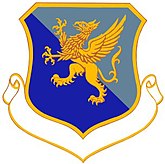35th Air Division
35th Air Division
 | |
|---|---|
 | |
| Active | 1951–1958; 1966–1969 |
| Country | |
| Branch | |
| Role | Command of air defense forces |
| Part of | Air Defense Command |
| Insignia | |
| 35th Air Division emblem (Approved 20 April 1966)[2] |  |
The 35th Air Division (35th AD) is an inactive United States Air Force organization. Its last assignment was with Air Defense Command, assigned to First Air Force, at Hancock Field, New York. It was inactivated on 19 November 1969.
History
[edit]
Assigned to Air Defense Command (ADC) for most of its existence, from July 1951 – November 1969, the 35th "equipped, administered, and trained its assigned and attached units and placed those forces in a maximum state of readiness for use in air defense. Initially, its area of responsibility included all or part of Tennessee, North Carolina, South Carolina, Georgia, Alabama, Florida, and Mississippi".[2]

"In 1966, the area changed to include most of New York, Vermont, New Hampshire, Massachusetts, and southern Maine when the division assumed the responsibilities of the inactivated Boston Air Defense Sector. "[2]
Assumed additional designation of 35th NORAD Region after activation of the NORAD Combat Operations Center at the Cheyenne Mountain Complex, Colorado and reporting was transferred to NORAD from ADC at Ent Air Force Base in April 1966. "The division participated in numerous live and simulated exercises such as Apache Brave, Mohawk Echo, and Desk Top."[2]
Inactivated in November 1969[2] as ADC phased down its interceptor mission as the chances of a Soviet bomber attack on the United States seemed remote, its mission being consolidated into North American Aerospace Defense Command (NORAD).
Lineage
[edit]- Established as the 35 Air Division (Defense) on 11 June 1951
- Activated on 1 July 1951
- Inactivated on 1 February 1952
- Organized on 1 February 1952[3]
- Inactivated on 15 November 1958
- Redesignated 35 Air Division and activated on 20 January 1966 (not organized)
- Organized on 1 April 1966
- Inactivated on 19 November 1969[2]
Assignments
[edit]- Central Air Defense Force, 1 July 1951 – 10 April 1955
- Eastern Air Defense Force, 10 April 1955 – 15 November 1958
- Air Defense Command, 20 January 1966 (not organized)
- First Air Force, 1 April 1966 – 19 November 1969[2]
Stations
[edit]- Kansas City, Missouri, 1 July – 1 September 1951
- Dobbins Air Force Base, Georgia, 4 September 1951 – 15 November 1958
- Hancock Field, New York, 1 April 1966 – 19 November 1969[2]
Components
[edit]Sector
[edit]- Gunter Air Force Base, Alabama, 8 September 1957 – 15 November 1958
Wing
[edit]- 52d Fighter Wing (Air Defense)[2]
- Suffolk County Air Force Base, New York, 1 December 1967 – 30 September 1968
Groups
[edit]- Suffolk County Air Force Base, New York, 30 September 1968 1966 – 31 December 1969
- McGhee-Tyson MAP, Tennessee, 18 August 1955 1966 – 1 March 1956
- McGhee-Tyson MAP, Tennessee, 16 February 1953 1966 – 18 August 1955
Interceptor squadron
[edit]- Loring Air Force Base, Maine, 15 September 1966 – 19 November 1969
Missile squadrons
[edit]- 26th Air Defense Missile Squadron (BOMARC)
- Otis Air Force Base, Massachusetts, 1 April 1966 1966 – 19 November 1969
- 35th Air Defense Missile Squadron (BOMARC)
- Niagara Falls Air Force Missile Site, New York, 15 September 1966 – 19 November 1969
- 46th Air Defense Missile Squadron (BOMARC)[2]
- McGuire Air Force Base, New Jersey, 1 December 1967 1966 – 1 October 1972
Radar squadrons
[edit]
|
|
See also
[edit]- List of United States Air Force Aerospace Defense Command Interceptor Squadrons
- List of United States Air Force air divisions
- United States general surveillance radar stations
References
[edit]Notes
[edit]- ^ Aircraft depicted is F-106B serial number 57-2523
- ^ a b c d e f g h i j k l m "Factsheet 35 Air Division". Air Force Historical Research Agency. 5 October 2007. Archived from the original on 23 October 2012. Retrieved 9 April 2014.
- ^ The simultaneous activation and inactivation in February 1952 represents a change between a table of organization unit and a table of distribution unit
Bibliography
[edit]![]() This article incorporates public domain material from the Air Force Historical Research Agency
This article incorporates public domain material from the Air Force Historical Research Agency
- Cornett, Lloyd H; Johnson, Mildred W (1980). A Handbook of Aerospace Defense Organization, 1946–1980 (PDF). Peterson AFB, CO: Office of History, Aerospace Defense Center. Archived from the original (PDF) on 13 February 2016. Retrieved 23 March 2012.
- Winkler, David F.; Webster, Julie L (1997). Searching the skies: The legacy of the United States Cold War Defense Radar Program. Champaign, IL: US Army Construction Engineering Research Laboratories. LCCN 97020912.[dead link]
- "ADCOM's Fighter Interceptor Squadrons". The Interceptor. 21 (1). Aerospace Defense Command: 5–11, 26–31, 40–45, 54–59. January 1979.

